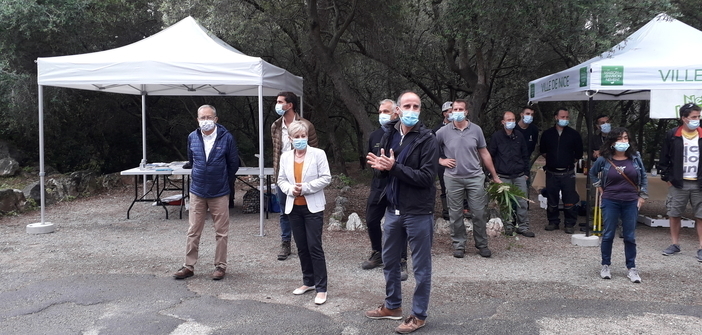The House of the Environment organized a bush clearing operation this Wednesday, June 2nd. Supported by the Nice Plogging Association and the City of Nice’s Green Spaces Department, its mission is to protect nature from harmful plants. How? By pulling out those that attempt to drive out the local flora.
“We can’t do anything alone.” At the outset, Professor Richard Chemla, Deputy for Health and Environment, wanted to convey an evident truth. “We cannot play the apprentice wizard. The species you are going to pull out were introduced, like Caulerpa taxifolia. Therefore, it is important to protect biodiversity.” A cause he is ready to discuss with those interested.
A Tough but Pleasurable Mission
To eradicate these weeds, we must go about it without fear of getting our hands dirty. “We use no chemical or phytosanitary products. The city of Nice is committed to a “zero phyto” goal,” Alexis Maïa states. Despite the rain, nothing discouraged these 45 extreme pullers. The meeting was scheduled for 9 am. The task was not restful. The roots of Senecio deltoideus are very deep. But everything is done to pamper these defenders of nature: fruit juice, coffee, croissants—enough to provide energy during these 2.5 hours of work.
To accomplish this mission, the organization is well-honed. Cultivator, hoe, pruning shears, gloves, hand hoes… There’s something for everyone. Among these amateur gardeners, children, adults, and seniors support each other.
To do this, the volunteers are divided into four groups. The aim is to “cast a wide net”. It’s another stepping stone to add to the construction. Mont Boron represents, after all, 57 hectares of land. In the end, 10 m3 of plants were gathered.
Senecio: A Harmful Plant
Before jumping into the fray, caution must be exercised with Senecio deltoideus like the plague: “it is characterized by finer foliage. It is also very creeping and can easily take flight. It is very volatile and attaches easily to animals, plants, or even our clothes. It has a lifespan of one week and a very fast reproduction rate.” For the record, it was introduced in 1936 from South Africa.
This species can have serious consequences on other plants. Some could eventually disappear from the face of the earth. “This is the case with the Nice Snowflake. If it disappears from here, it will be untraceable in the rest of the world. It is a small snowdrop that bursts a white flower from its bulb,” explains Alexia Maïa.
An objective that Catherine Moreau, Deputy for Urban Agriculture and Community Engagement, wants to support. The goal would be to preserve the entire network of living species. “We will work with Richard Chemla on steeper areas of trails where we could consider accommodating beekeeping or pastoralism. To be able to restore a purpose of promenade to this park, but also of biodiversity life.”


